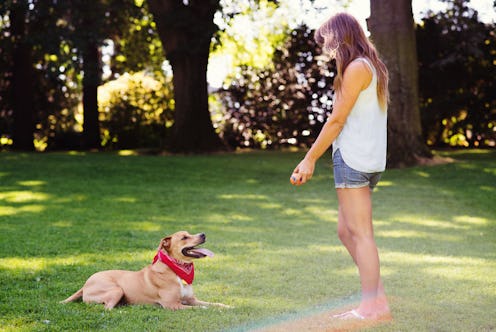Life
What Your Dog Really Thinks When You Throw A Fake Ball Will Make You Feel So Hard

One of the highlights of my day is walking to my local park for the sole purpose of watching — and interacting — with dogs. What used to fill my heart with joy was the fake thrower. You know, that one mischievous owner that fake throws a ball to see how their dog will react. There are two outcomes: the believer or the dog that catches their bluff. But what does your dog think when you fake throw a ball?
Disappointment, sadness, and frustration are just some of the emotions I felt when I discovered how dogs can feel to a fake ball being “thrown”. Dogs have feelings too y'know, and teasing them with a pastime they truly love is just downright criminal. How would you feel anticipating something that you truly desire, only to discover it was never going to happen in the first place? Ugh. I just want to scoop these fur babies up and save them from the torment of fake ball throwing. How could I have found those memes of disappointed dogs so funny — someone give me the cone of shame.
To fully understand how these precious little pups can experience the barbaric practice, I spoke with dog behaviourist and trainer Denise Nuttall. You’ll never want to fake throw ball every again, I’m telling you that now. Once you initiate the classic game of fetch with your pooch, they know off the bat that this game will end in a positive consequence, i.e. they get that sweet reward of retrieving the ball. But what happens when there isn’t a ball at all?
“When that positive consequence doesn’t transpire, [your] dog’s expectations aren’t met. In actual fact, it leads to disappointment,” Nuttall explains to me. “[Your] dog is disappointed because they were expecting the ball to be thrown and have this game … so [your] dog will essentially experience disappointment.” Yes, you read that correctly. What you thought was just harmless teasing actually makes your dog experience emotional discomfort. Which, as Nuttall informs me, is actually seen as a punishment in “proper dog training terms”.
The way in which humans and dogs process teasing — and the emotion that comes with it — is more similar than you may think. According to an experiment conducted by Hungarian ethologists in 2014, both humans and canines share “brain sensitivity to vocal cues of emotional valence.” In layman’s terms, humans and dogs share a sensitivity to emotion, which makes communication between dogs and their owners even more important.
Dogs even “undergo the same chemical changes that humans do during emotional states,” according to a 2013 Psychology Today report. Nuttall also mentions this in our conversation. “In terms of what happens in the brain, when you have expectation and anticipation you get a dopamine rush and when that doesn’t happen, there’s a crash,” she explains. There is so much more to learn about our canine friends, and it’s clear that you need to take their feelings into account when it comes to teasing.
To think that your dog can go through a myriad of emotions when you fake throw a ball is disheartening. Nuttall tells me: “The emotion of disappointment can cause some frustration because when we are disappointed we get frustrated. Some dogs, if they have a very short fuse, can get damn right cross about it, so it depends on the dog as well.”
When you are tempting to tease your beloved pooch, just stop and think about it for a second. What’s the end goal? What are you going to achieve by teasing? It may be funny for you, but it sure as hell isn't funny for your dog. With the knowledge that dogs and humans share more cognitive similarities than previously thought, perhaps it’s time to take their feelings into account.